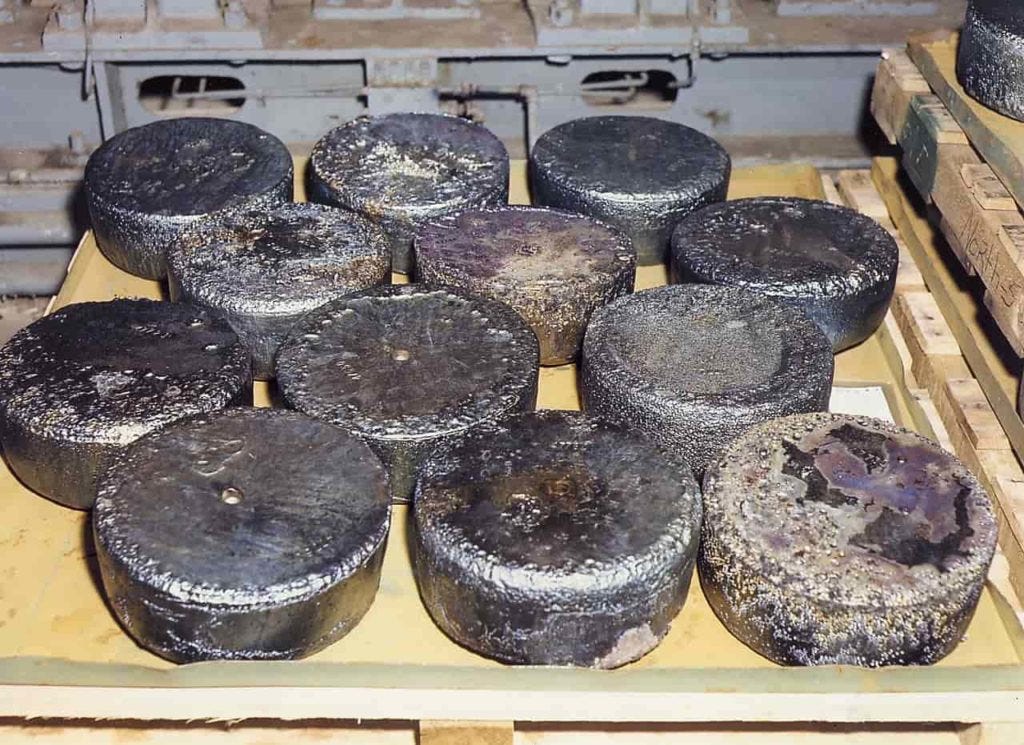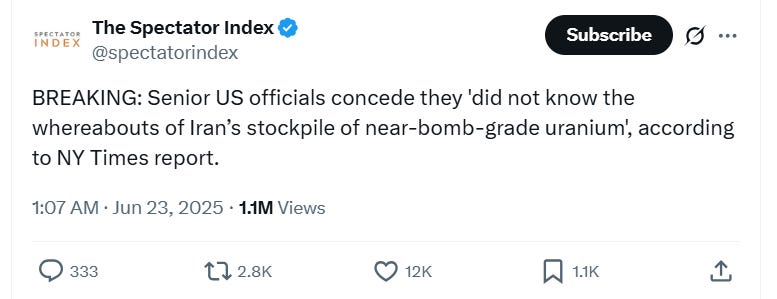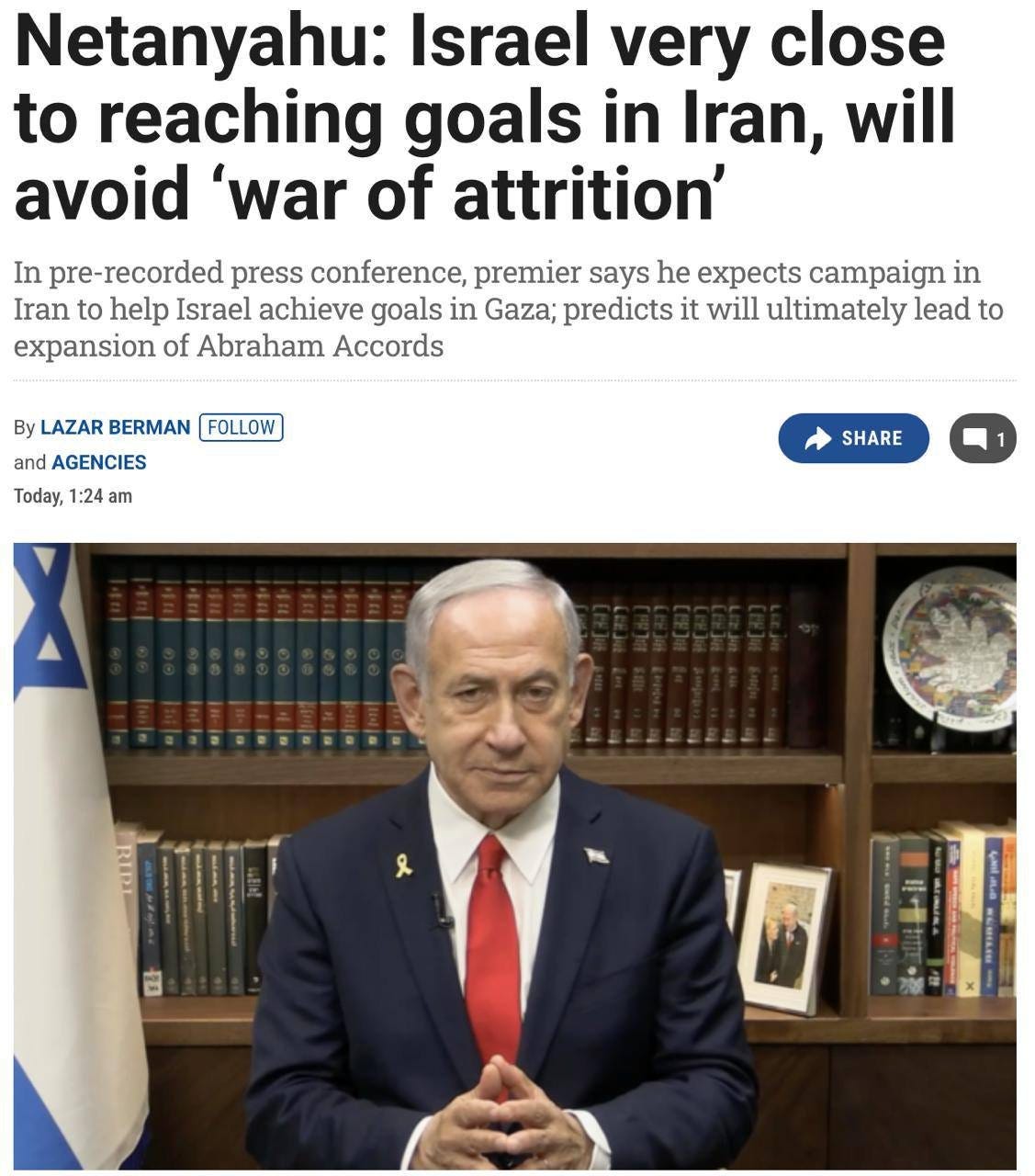One and Done?
Operation Midnight Hammer hit empty infrastructure, not enriched uranium—leaving the US potentially mired in a long, slow pursuit of Iran’s nuclear potential.
President Trump was quick to declare “mission accomplished,” boasting that his midnight strikes on Iran’s nuclear sites—Fordow, Natanz, and Isfahan—had “obliterated” the country’s nuclear weapons threat. While debate rages over how much physical damage the bombs actually inflicted—surface scratches or deep destruction—the reality is simpler: Operation Midnight Hammer amounted to little more than slamming the barn door after the nuclear horses had already bolted. Whether the attack succeeded tactically is beside the point—strategically, it was a failure. All it has done is force Iran into a binary choice between the fate of non-nuclear Libya and the path of nuclear armed North Korea. And it doesn’t take a genius to see which direction Tehran must now take to avoid being caught lacking.
In response to the American strikes, Iran has pledged not only to continue uranium enrichment but to accelerate it. Whether this effort resumes at Fordow or shifts to undisclosed underground facilities remains unclear—no independent assessment of the damage at Fordow has been made public. Multiple sources, including Israeli analysts, have indicated that the heavily fortified enrichment hall may have withstood the assault. On the morning of June 23rd, Israeli forces reportedly demolished the access road to the complex, effectively sealing it off and forestalling any near-term inspection that might contradict the US President’s triumphant declaration of mission accomplished.
Yet what we’re witnessing is a TikTok strategy for an ADHD age—a flashy set piece packaged as a final act, even as the real narrative is only just beginning. In geopolitical terms, the US and Israel have offered the illusion of resolution: a single, high-drama airstrike meant to symbolically “close the file” on Iran’s nuclear ambitions. But if the real objective is to stop Iran from becoming a nuclear weapons state—and there are plenty of reasons to doubt that’s even the primary goal—then this operation is not a conclusion. It’s merely the first scene in what promises to be a long, multi-season geopolitical docudrama, one that could stretch across years, if not decades.
In the best-case scenario for Israel, Iran currently holds around 400 kilograms of uranium enriched to 60% purity. That’s enough for roughly ten nuclear warheads and forms the foundation of a credible deterrent. Advancing from 60% to weapons-grade enrichment at 90% is technically straightforward—and it’s entirely possible that Iran has already made that leap with part of its stockpile. If Israel is truly committed to preventing Iran from becoming a nuclear power, it must prepare for a sustained campaign of disruption and containment. This will not be resolved with a single strike. The only definitive endpoint to this standoff may come when Iran decides to conduct a nuclear test.
MAGA Chasing MacGuffins
In classic film theory, a MacGuffin is the object that drives the plot—a statue, a suitcase, a nuclear formula. It’s what the characters chase, but it often holds little intrinsic meaning. Alfred Hitchcock made the term famous: the MacGuffin is what the story pretends to be about, while the real drama unfolds in the pursuit. Think of The Maltese Falcon, or the glowing briefcase in Pulp Fiction. In this case, the uranium is the MacGuffin—everyone claims to be hunting it, even if no one knows exactly where it is or what they’re prepared to do to recover it.
Just consider the scale of what would be required. It took the US months of occupation, tens of thousands of troops, and vast intelligence resources to locate a single man—Saddam Hussein. Now imagine trying to track down a dispersed stockpile of highly enriched uranium, hidden across a country the size of Alaska, in bunkers, basements, and mobile labs. The idea that a handful of precision strikes could neutralize Iran’s nuclear capability isn’t just optimistic—it’s strategic fiction.
So if the uranium is the MacGuffin in this unfolding drama, then chasing it means tracking a scattered herd of wild horses across deserts, tunnels, cities, and mountains. It might make for compelling cinema. But as a military doctrine, it’s a roadmap to quagmire—a long, grinding war of attrition that ends with MAGA boots on Iranian soil.
Breaking the Rules-Based Order
In response to the US-led strikes on its nuclear facilities, Iran is threatening to withdraw from the Nuclear Non-Proliferation Treaty (NPT). This would mark a seismic shift in global nuclear governance. It is worth remembering that the NPT was originally written and aggressively promoted by the United States in the late 1960s, entering into force in 1970. Its goal was to formalize the distinction between nuclear-armed states (those that had tested nuclear weapons before 1967) and non-nuclear states, while offering the latter a grand bargain: in exchange for forgoing the development of nuclear weapons, they would be granted the right to pursue peaceful nuclear energy programs under international supervision.
The NPT's fundamental logic is surveillance in exchange for sovereignty: non-nuclear states retain their right to enrich uranium and build nuclear infrastructure, so long as they do so transparently under the watch of the International Atomic Energy Agency (IAEA). That is the essence of the so-called "rules-based international order" when it comes to nuclear policy.
Iran, notably, remains a signatory to the NPT and has, according to most expert assessments and IAEA monitoring reports, stayed within the letter of the agreement. It is not illegal for Iran to enrich uranium up to 60% purity—a level that is technically below weapons-grade—as long as this activity is declared and inspected. Even if one believes that Iran has a clandestine weapons program operating parallel to its civilian infrastructure, the existence of such a shadow program has not been verified by Western intelligence and certainly not by international inspectors. If these facilities exist, they remain unlocated and therefore unstrikeable.
This raises an uncomfortable truth: the United States and its allies have now attacked the declared, monitored infrastructure of an NPT-compliant country. This is not just a diplomatic contradiction—it is a gross violation of international law. Under the NPT, member states are explicitly prohibited from attacking one another’s safeguarded nuclear sites. The attack on Iran's nuclear program is not only a strategic gamble but a breach of the very framework the West helped create to stop nuclear proliferation.
Meanwhile, Israel—the state most aggressively pushing for military action against Iran—has never signed the NPT, and so paradoxically has more legal flexibly to attack Iran. It maintains a longstanding policy of nuclear opacity, refusing to confirm or deny the existence of its arsenal, though it is widely believed to possess over 200 nuclear warheads. Unlike Iran, Israel has never allowed IAEA inspections, never declared its stockpiles, and operates entirely outside the rules-based system it accuses others of violating.
On paper—and for the most part in practice—it wasn’t Iran that first walked away from the so-called rules-based order. Tehran, to be sure, has tested the boundaries, pushing hard against the upper limits of the NPT in an effort to force sanctions relief. But it was the West that ultimately flipped the table, abandoning the very treaties it once authored in favour of an ad hoc doctrine of "might makes right." If Iran now chooses to withdraw from the NPT, it won’t be breaking the system. It will be responding to a system already broken—one that punished compliance and rewarded power. If Iran now hopes to ascend and survive in a world governed by raw force, it must rapidly adapt its war-making capabilities and deepen its strategic alliances.
Iranian Attrition
While it’s obvious that both Russia and China have strong incentives to see the US bogged down in a draining war of attrition against Iran, what’s less acknowledged is that America’s own domestic elite share the same incentive. What better way to neutralize the populist right “menace” than to ship its sons off to die in the desert—for Israel? For the Uniparty, “winning” means MAGA youth bleeding out on the approaches to Tehran. They don’t want another Iran–Iraq war; they want an Iran–MAGA war. Every fallen soldier is a double victory: the populist threat is bled, and the forever war machine is fed. Trump and his war party influencers are already turning their fire on the anti-war wing of MAGA with the fervor of inquisitors rooting out heresy. What better fate for these faint-hearted dissenters than to atone with a one-way ticket for uranium hunting in Persia?
It is difficult to take wartime statements at face value, especially when deception is rewarded and truth-telling can be a liability. There are reports suggesting that Israel, through indirect channels, is signalling to Iran a willingness to consider a ceasefire. Following US strikes that triggered threats against American bases, some air defense assets originally deployed to shield Israel may have been redirected to protect US personnel. However, given the extent of American political and emotional fetishization of Israel, it's unclear whether such a strategic reallocation would actually be prioritized.
Yet, as the US learned in Ukraine, ending a war requires both sides to turn off the tap. While neither Israel nor the US may seek a prolonged war of attrition—especially as they reportedly face shortages of air defense interceptors—Iran appears to be adapting. Fewer missiles are being launched, but a greater proportion are now penetrating Israeli defenses.
Israel, for its part, has entered a counter-value targeting phase, striking civilian infrastructure deeper inside Iran. This strategy failed to deliver decisive results even in the tightly confined battleground of Gaza. Iran, by contrast, is vast—and even if the political will existed, neither Israel nor the US possesses the arsenal or endurance to sustain a campaign of mass destruction across such a sprawling terrain. Iran, on the other hand, holds a large and growing inventory of ballistic missiles, and Israel remains a small, densely populated state.
Against this backdrop, Trump’s insistence that the mission has “obliterated” Iran’s nuclear threat reads less like triumph and more like an attempt to avoid being dragged deeper into the Iranian tar. Even if this chapter of the regime-fragmentation campaign against Tehran may seem to be drawing to a close—for now. Give it a few months, and the next episode will be ready for release.
The Iranian Trap
The tale of the Tar-Baby, drawn from African-American folklore and popularized in the 19th-century Uncle Remus stories, tells of Br’er Rabbit who, enraged by a silent tar figure that he mistakes for a snubbing stranger, strikes it—only to become stuck, limb by limb, in the sticky trap. The more he struggles, the deeper he’s caught.
The story has long served as a metaphor for entrapment: a situation that tempts retaliation, but punishes it with irreversible commitment. In military terms, this is known as a pinning-down operation—where one party lures another into a fight it can’t easily escape.
The Iranian nuclear program is today’s tar-baby. The US and Israel, believing they can strike it decisively, have instead initiated a process that may bind them to years of strategic and kinetic engagement. Each strike meant to send a message or "restore deterrence" only deepens the entanglement, forcing ever-more commitments to maintain credibility. Iran, aware of this logic, is now goading them into further reaction, knowing the more punches they throw, the more stuck they become.
We can also reverse this metaphor. In the original folktale, the tar-baby is the trap — a snare that catches those who lash out. But in the US–Iran saga, it’s just as true that Washington also plays the role of the tar-baby, luring Tehran into entanglement not through provocation, but through the illusion of diplomacy. The question, then, is: why does Iran keep reaching out? Why risk another encounter with the West’s sticky promises?
The answer lies in a persistent, perhaps fatal hope: that sanctions relief — the great prize of engagement — might one day be real. The 2015 nuclear deal, the Joint Comprehensive Plan of Action (JCPOA), negotiated under Obama, represented the high-water mark of this aspiration. Iran complied. It accepted intrusive inspections and capped enrichment. In return, it got temporary relief — until Trump tore up the agreement, reimposed sanctions, and demonstrated beyond doubt that the US is, in the words of many Iranian officials, "agreement incapable."
Still, the temptation remains. Iranian liberals look across the Persian Gulf at the skyscrapers of Dubai and Doha — the financial opulence of US-aligned Gulf monarchies — and dream of a future in the global economy. That fantasy acts as the honey pot in America’s trap. But unlike the Gulf States, Iran will never be permitted to integrate into the US-led order. Its independence is its original sin. Washington will always find a pretext to keep sanctions in place. Iran might be wiser to take a page from Russia’s book: accept the permanence of Western hostility, forget their American dreams, build resilience, and chart a sovereign economic course.









Don't kid yourself.
The lack of Iranian response has Trump already talking regime change. If the provocations don't get the desired response, just keep hitting harder until you get what you want. It's a no-lose option from the neocon perspective.
Anyway, we heard similar cope following Trump's attacks on Syria. Eventually, the neocons got the failed state that they were seeking.